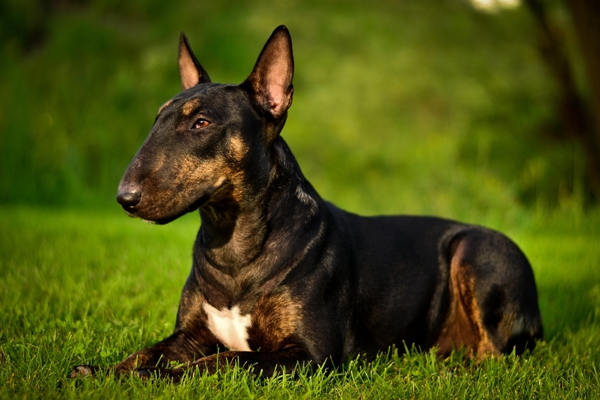The History of the Bull TerrierThe family tree of the Bulldog is massive with many branches. One of those branches holds the bull-and-terrier breeds, the various results of 18th-century crosses between bulldogs and terriers. Those crosses were made with the intent of producing a dog with the strength and tenacity of the bulldog and the intensity, alertness, agility and “game” nature of the terrier. The earliest Bull Terriers came in a variety of sizes. Some were as small as four to seven pounds and were considered toy breeds. Others were medium-size at 15 pounds and some ranged up to 45 to 60 pounds, close to the size of the modern Bull Terrier. They had an arched back, bent legs and an undershot jaw, all features that were reminiscent of the breed’s bulldog heritage. James Hinks of Birmingham, England, was a well-known breeder of Bull Terriers in the 1860s, and it was he who started them on the road to the more refined look they have today: the longer head and the more symmetrical body that was predominantly or completely white. To create them he used existing bull-and-terriers, his white Bulldog Madman, and white English Terriers, which are now extinct. Nicknamed White Cavaliers, they became fashionable accessories for gentlemen about town and could be soon sitting alongside them as they drove their carriages through the park. A rhyme of the time tells the story of the breed succinctly, saying that Hinks “Found a Bull Terrier a tattered old bum; Made him a dog for a gentleman’s chum.” The fad spread to the United States. The American Kennel Club recognized the breed in 1885, and the Bull Terrier Club of America was founded in 1897. A new variety of Bull Terrier was invented in the early 20th century when some breeders crossed them with Staffordshire Bull Terriers, adding color to the coat. The “Colored” variety of Bull Terrier was recognized in 193 Today the Bull Terrier ranks 53rd among the breeds registered by the AKC.
Sign up and make sure you are always on top of the most important info for you and your pets.
He needs frequent brisk walks, occasional vigorous games of ball, and total immersion in the family, i.e. LOTS of companionship and interactive play sessions.
This muscular, forceful, vigorous dog does best with active families, for he has a high energy level that comes in spurts and bursts.
An English Bull Terrier should not be kept with another dog of the same sex, and cats may or may not be safe. Bull Terriers can be very possessive of their food – do not allow another pet or a child to approach a Bull Terrier when he is eating..
At some point, if you have not raised this breed with consistent leadership, he will likely challenge your ability to control his actions. Such dominance attempts must be met with calm assertiveness. Keep training sessions brief but frequent to keep drilling home the commands he needs to learn.
Dog training videos. Sometimes its easier to train your puppy (or adult dog) when you can see the correct training techniques in action. The problem is that most dog training videos on the internet are worthless, because they use the wrong training method. I recommend these dog training videos that are based on respect and leadership.
Sign up and get a $250 New Pet Starter Kit!
The Bull Terrier should do well on a high-quality dog food that is appropriate to the dog’s age (puppy, adult, or senior) and level of activity.
According to the AKC, Bull Terriers need a good diet that includes natural calcium, such as broccoli or plain yoghurt, especially when they are youngsters going through periods of rapid growth and bone development.
Bull Terriers are often quite food possessive and may show aggression towards other pets or humans who approach their meal. It’s best to leave them be to eat.
Treats can be an important aid in training a Bull Terrier, but some are prone to getting overweight, so watch your BT’s calorie consumption and weight level. Check with your vet if you have any concerns about your dog’s weight or diet.


Easy to groom and care for, the Bull Terrier’s short, flat, harsh, and glossy coat requires minimal maintenance. A weekly brushing with a soft brush or glove will help to remove dirt and loose hair and keep the dog looking its best.
BT’s can be prone to skin allergies, and if living outdoors, it’s recommended to give them a wash at least once a week.
Not all conditions are covered by Pet Insurance. For details of Bow Wow Meow Pet Insurance cover, refer to the Product Disclosure Statement.
Jam packed with news, tips and advice on how to provide the best possible care for your Bow Wow or Meow!